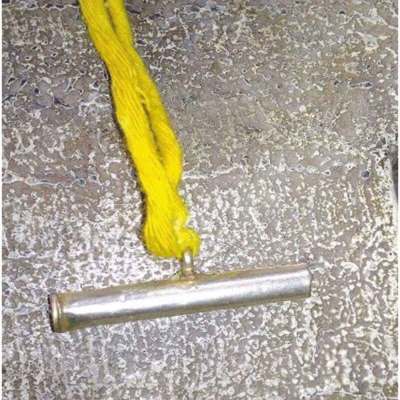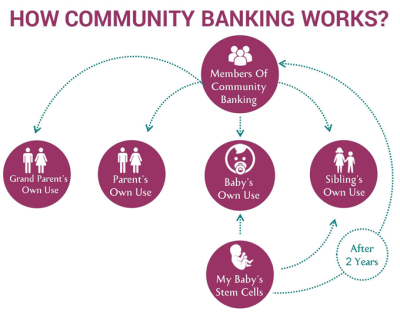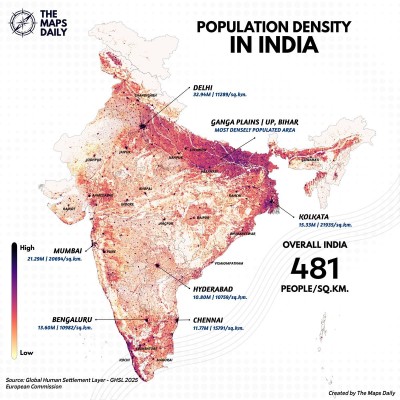You are here
Marketing of Cord Blood Banking in India
Marketing family cord blood banking in a manner that will appeal to consumers is not an endeavor where one size fits all. India presents a unique and evolving environment where many factors play a role in outreach to families about cord blood banking.
Since 2023, India has become the world’s most populous country, with a current population over 1.429 billion people (click on the accompanying map to expand)1,2. About 60 years ago, India was also a rapidly growing country, with a fertility rate of about 6 children per woman1,3. Whereas now, the fertility rate is down to about 2.0, slightly below the rate of 2.1 that is needed for a population to sustain itself1,4. However, after decades of high birth rates, India still has a youthful population. The median age in India is 30 years old and 40% of the population is below age 251,4. There are about 24 million births per year in India4. Family cord blood banks in India have estimated that they penetrate 0.4% of the birth market in the cities, where about one third of the population are living5.
The economy of India is currently the world’s fifth largest and one of the fastest growing in the world6. Deloitte reported in spring 2024 that India’s Gross Domestic Product (GDP) has grown by over 8% for three consecutive quarters7. Historically, there has been a large inequality between the rich and the poor in India, and this continues to be true in agricultural regions, but in industrial regions there is a rapidly growing middle class7,8. In their study on the economic outlook for India, Deloitte noted that there is a shift in consumer behavior toward “aspirational spending” on luxury and premium goods and services7. They predicted that India’s consumer market will become the world’s third largest by 20277.
Indian traditions about the afterbirth
The Vedic religious texts describe cord blood as a source of life9. “Furthermore, for South Asians in general, blood is often considered a repository of strength”10. In some parts of India, it has been a custom for centuries to take the stump of the umbilical cord, dry it out, and powder it9,10. This powder is stored in an amulet made of silver or gold which is worn by the child (see the accompanying image)10. It is believed that in the event of a serious illness, the child can ingest this powder to restore their strength9,10. There are also numerous folk tales of infertile women who finally conceived after consuming the dried powder of a donated umbilical cord9. Thus, spiritual beliefs that have existed in the Indian culture since ancient times parallel the modern practice of preserving stem cells against the need for regenerative therapy. To the Indian way of thinking, the new story of perinatal stem cells is part of the older story that the afterbirth has the power to bring new life.
 Healthcare landscape in India
Healthcare landscape in India
India has state-of-the-art hospitals, and is one of the most popular destinations for medical tourism11. But access to medical care is very uneven across India, with the cities having much better infrastructure than rural areas. Healthcare insurance is provided by a variety of public and private networks, many of which require significant payments directly from the pockets of patients11. For example, in 2019, 55% of spending by Indian patients on healthcare was out-of-pocket expenses11. This situation leaves Indian families with chronic concerns about access to affordable medical care.
One area of medical practice where India is racing to catch up with the West is equipping specialty hospitals that can perform stem cell transplants. In the year 2016, the rate of stem cell transplants in the US population was 27 per million, whereas in India it was 19 times lower, only 1.4 per million12,13. While India has registries of bone marrow donors, there is no public network of cord blood donations14. Patients in India who need a stem cell transplant may have a hard time finding a donor. Also, the hospitalization cost of a stem cell transplant from a donor runs INR 15-20 lakhs, which is very expensive in a country where the average salary for the age group 25-34 is INR 10,78015,16. Indian consumers that are aware of these barriers to stem cell transplant access are likely to perceive family cord blood banking as a logical way to secure stem cells that are at least partially matched to their family members.
India has an additional public health burden due to the prevalence of the inherited blood disorder Thalassemia. The most serious variant, called Beta Thalassemia, leads to severe anemia and early death, unless it is cured with a stem cell transplant17. There are approximately 35-45 million carriers of Beta Thalassemia in India, because on average 3-4% of the population are carriers18. Hence, 10,000 babies are born each year in India that have inherited the gene from both parents and have the Beta Thalassemia disorder which requires extensive treatment so that the child may survive18. By comparison, there are at most 1,500 patients in the entire US with this condition19. The possibility that their child may be born with Thalassemia and will require a stem cell transplant is an additional motivation for parents in India to bank cord blood from their children.
Unique aspects of marketing in India
The marketing of cord blood banking in India is highly personalized. When parents request information from a family banking service, the bank will send a sales representative to visit the parents in their home and make a personal presentation. This may seem shocking to Westerners, where a large portion of shopping research and the actual purchase are all conducted on-line. But it is also true that many parents in the West think of cord blood banking as an optional add-on. Whereas, given the healthcare landscape in India, parents in India tend to take cord blood banking quite seriously as a form of insurance for their family. When making a major commitment to a biologic insurance policy, consumers expect a personalized introduction to the options they might purchase. Also, the privacy of a consumer’s home is a more comfortable place to have a conversation about the family health history and the risk factors that might drive the decision. It is not unusual for a cord blood bank in India to have hundreds of sales representatives, both women and men, that specialize in different geographic regions and different communities.
 Community Banking is a concept that was invented by the family bank LifeCell International, and it is so popular with consumers that other banks in India and even in Singapore have adopted similar models20,21. In this business model, a community of parents agrees to share their children’s cord blood with each other. The community pool is like a private bank, in that members pay to participate and get a storage service in return. But the community pool is also like a public bank, in that the members agree to donate their own child’s cord blood if another member needs it. When parents sign up for community banking, the members of their family that may participate include not only the child that contributed the cord blood, as well as the siblings of that child, but also the parents and grand-parents of the child. “The community banking model is as new as the sharing economy that brought us Airbnb and Uber, and as old as the mutual aid societies that evolved to become today’s insurance companies”20.
Community Banking is a concept that was invented by the family bank LifeCell International, and it is so popular with consumers that other banks in India and even in Singapore have adopted similar models20,21. In this business model, a community of parents agrees to share their children’s cord blood with each other. The community pool is like a private bank, in that members pay to participate and get a storage service in return. But the community pool is also like a public bank, in that the members agree to donate their own child’s cord blood if another member needs it. When parents sign up for community banking, the members of their family that may participate include not only the child that contributed the cord blood, as well as the siblings of that child, but also the parents and grand-parents of the child. “The community banking model is as new as the sharing economy that brought us Airbnb and Uber, and as old as the mutual aid societies that evolved to become today’s insurance companies”20.
The community model of cord blood banking is well suited to both the cultural traditions and the healthcare landscape of India. From a medical perspective, the ability to use the baby’s stem cells for multiple family members overcomes the fact that India does not have active public cord blood banks14. Community banking is also consistent with the Indian tradition of giving high priority to community values. In India over 90% of marriages are arranged by the parents of the couple, and marriages are almost always within the same religion and the same caste22. Grand-parents and adult children often live together in joint households23. Thus, it makes perfect sense that sales representatives of cord blood banks should visit the home of the expectant parents, where the extended family can participate in the discussion about banking.
 Indian consumers are described as being very price conscious, so that the overall cost and the payment plans offered are important aspects of competing in the family banking market of India. Insurance to cover the cost of a transplant with the banked cord blood is an essential component of consumer services in India. The community banking model pioneered by LifeCell includes a payment of INR 20 lakhs towards medical expenses if any member of the covered family should need a stem cell transplant, for the initial 21 years of the contract20. The policy of paying INR 20 lakh towards a stem cell transplant has been adopted by other family cord blood banks in India, for example Biocell, Cordlife, Cryoviva, and StemCyte21.
Indian consumers are described as being very price conscious, so that the overall cost and the payment plans offered are important aspects of competing in the family banking market of India. Insurance to cover the cost of a transplant with the banked cord blood is an essential component of consumer services in India. The community banking model pioneered by LifeCell includes a payment of INR 20 lakhs towards medical expenses if any member of the covered family should need a stem cell transplant, for the initial 21 years of the contract20. The policy of paying INR 20 lakh towards a stem cell transplant has been adopted by other family cord blood banks in India, for example Biocell, Cordlife, Cryoviva, and StemCyte21.
Summary
India's vast population presents fertile ground for cord blood banking, but marketing strategies must be tailored to India’s unique mix of demographics, economic factors, healthcare policies, and cultural traditions. Personalized marketing approaches, such as in-home consultations, play a crucial role in India. Community banking is gaining in popularity because it fits well with the social values and healthcare needs of the country. As consumer spending grows in India, it can be expected that family cord blood banking will continue to be an important part of family planning.
References
- Dotto C, and Mogul R. How India’s population exploded to overtake China’s and what’s next. CNN. Published 2023-07-09
- Worldometer. Countries in the world by population (2024). Last updated 2023-07-16
- Gramlich J. For World Population Day, a look at the countries with the biggest projected gains – and losses – by 2100. Pew Research Center. Published 2019-07-19
- CIA. India. The World Factbook. Last updated 2022-12-27
- Verter F. Percentage of births banking cord blood by country. Parent's Guide to Cord Blood Foundation. Newsletter. Published 2020-01
- Silver C. The Top 25 Economies in the World. Investopedia. Last updated 2023-12-15
- Majumdar R. India economic outlook, April 2024. Deloitte. Published 2024-04
- The World Bank. World Development Indicators. Databank. Last Updated 2024-03-28
- Khosla S, Verma S, Datta S, Sharma S, Sharma R, Walia H, et al. A review of modern and Vedic practices on use of umbilical cord. J Obstetrics & Gynaecology. 2022; 42(7):2588-2591.
- Panwar, A. Medical Anthropology. 2023; 42(2):121–135.
- Kumar A. The Transformation of The Indian Healthcare System. Cureus. 2023; 15(5):e39079.
- United States Health Resources and Services Administration (HRSA). 2016; How many bone marrow or umbilical cord blood transplants are performed in the United States?
- Naithani, R. Hematopoietic Stem Cell Transplantation in India - 2017 Annual Update. Indian J Hem Blood Transf. 2018; 34(1):5
- WMDA. Global Trends Report. (requires membership) 2022 data published 2023-05-30
- Sharma SJ, Choudhary D, Gupta N, Dhamija M, Khandelwal V, Kharya G, Handoo A, Setia R, Arora A. Cost of Hematopoietic Stem Cell Transplantation in India. Mediterr J Hematol Infect Dis. 2014; 6(1): e2014046
- Tambe N, Jain A. Average Salary In India By Age (2024). Forbes. Published 2024-01-02
- John MJ, Jyani G, Jindal A, Mashon RS, Mathew A, Kakkar S, Bahuguna P, Prinja S. Cost Effectiveness of Hematopoietic Stem Cell Transplantation Compared with Transfusion Chelation for Treatment of Thalassemia Major. Biol Blood Marrow Transpl. 2018; 24(10):2119-2126.
- Colah R, Italia K, Gorakshakar A. Burden of thalassemia in India: The road map for control. Pediatric Hematology Oncology 2017; 2(4):79-84.
- Verter F. Role of Cord Blood Transplants to Treat Sickle Cell Anemia & Thalassemia in the Age of Gene Therapy. Parent's Guide to Cord Blood Foundation Newsletter Published 2023-08
- Verter F, Mandot V. The Business Model of Community Banking in India. Parent's Guide to Cord Blood Foundation Newsletter Published 2019-07
- Parent's Guide to Cord Blood Foundation. Family cord blood banking in India. Web page. Last updated 2024-04
- Rukmini S. What the data tells us about love and marriage in India. BBC. Published 2021-12-07
- Biswas S. Why Indians continue to live in joint families. BBC. Published 2020-09-13



